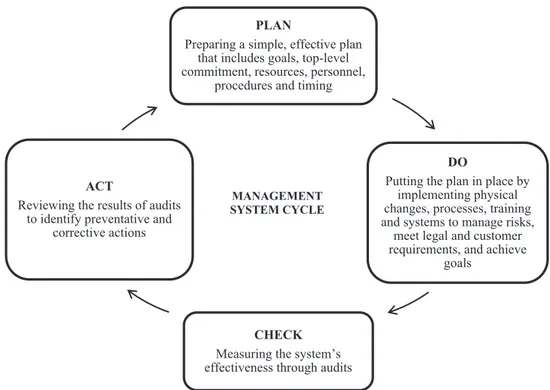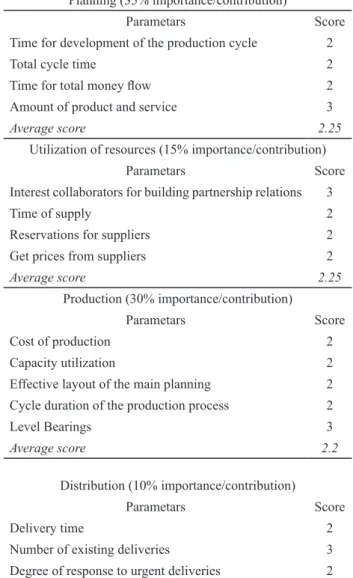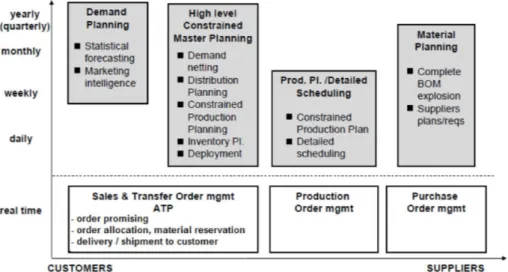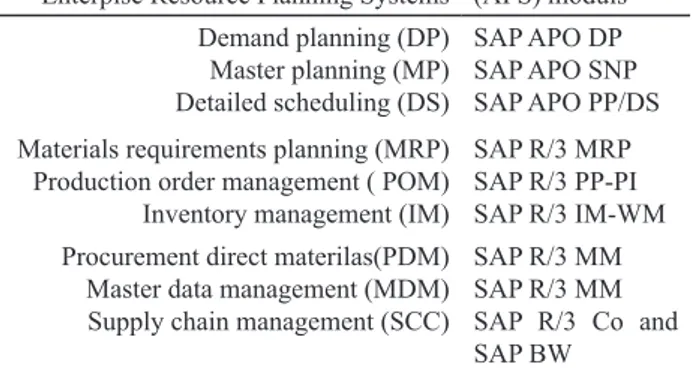ISSN 1409 - 8695 UDC: 658.86/.87:661.12 Case study
Implementation of Supply Chain Management (SCM) in
pharmaceutical company, general principles and case study
Zoran Nakov
1, Stevche Acevski
2, Rubincho Zareski
31Novo Nordisk Pharma DOOEL ,blvd. Oktomvriska Revolucija 18, 1000 Skopje, R. of Macedonia 2Alkaloid AD Skopje, blvd Aleksandar Makedonski 12, 1000 Skopje, R. of Macedonia
3Faculty of Pharmacy Skopje, str. Mother Tereza 47 , 1000 Skopje, R. of Macedonia
Received: October 2014; Accepted: December 2014
Abstract
Supply Chain Management (SCM) in pharmaceutical industry is deined as a “responsible SCM” and its implementation is according
to the principles of: business ethics, rights of labor and principles of healthy and safe working environment. Pharmaceutical companies with
implemented “responsible SCM” have to use management systems to facilitate continuous improvement in accordance with their working
principles. The main purpose of this management system is to ensure the consistency, reliability and continuous improvement of all
work-lows within an organization.The analyzed case describes the project of European generic pharmaceutical company, which intends to im
-plement best practice SCM operations for ive European manufacturing sites and European logistics organizations (active ingredients sup
-ply, distribution centers, afiliate customers and third party manufacturers). The main objectives of the project were the creation of the fu -ture improved To-Be situation through implementation of new SCM models to the existing To-Day situation.
Keywords: Supply chain management (SCM), responsible SCM, implementation, evaluation
* lbogdanovska@ff.ukim.edu.mk
Introduction for SCM
Supply Chain Management (SCM) is deined as sys -tematic and strategic coordination of the traditional busi-ness functions and their tactical coordination within the company itself, systematic and strategic coordination of the traditional business functions and their tactical coor-dination in cooperation with all business partners of the respective company, with one end point long-term
im-provement of performance of the company (Mentzer et al.,
2001). Generally, SCM is a combination of different disci-plines such as logistics, transport and distribution as part of the operational management system, marketing, part of the raw material’s orders and procurement of information
technology. The ultimate objective of SCM is to create co
-ordination between all the previously mentioned opera-tions in order to improve performance of a particular
com-pany (Peltz, 2008).
Unlike other industries in the pharmaceutical
indus-try SCM is upgraded and implemented as a “responsible SCM”. The term of responsibility is due to the fact that the
implementation of SCM in the pharmaceutical companies is according with principles of: business ethics; the rights of labor force and principles of healthy and safe work-ing environment (PSCI guidance, 2011).The pharmaceu-tical industry in the last two decades is faced by continu-ous changes in terms of testing and sales a new products.
The major changes are mandated by the health authorities
in the countries were companies produce or sale. Chang-es that are commonly encountered are: a permanent prChang-es- pres-sure on prices and tendency of the health authorities for
patent protection of original drugs and constant pressure from generic or biosimilar companies. Aimed in reducing their expenses, many pharmaceutical companies decide to merge their research and development process. The imple-mentation of SCM systems in pharmaceutical companies
is intended towards rationalization the process of planning, production, distribution and storage of the inal product be
-fore it comes to its inal customer/user. The process of ra
-tionalization, through the introduction of standard SCM
modules and systems in the pharmaceutical companies, on
the other hand allows decreasing the cost of the inal prod -uct, thus increasing its competitiveness compared to other similar products produced by the competitive pharmaceu-tical companies (Rees, 2011).
The main purpose of the SCM is to ensure the consis-tency, reliability and continuous improvement of all
work-lows within an organization. Pharmaceutical companies
with implemented responsible SCM should use manage-ment systems to facilitate continuous improvemanage-ment in ac-cordance with their working principles. By this process they ensure market competitiveness, able to meet the
spe-ciic requirements of certain countries in terms of the area
of business ethics, receive respectable relations with rep-resentatives of labor/trade unions, believe that these prin-ciples are best implemented through continuous improve-ment approach in everyday work activities, which indirect-ly leads to increased competitiveness (Cailet, 2011).
The cycle of this management system represented in Fig. 1 contains four separate activities: plan, do, check and action (PSCI guidance, 2011; ISO 14001, 2004).
Implementation of SCM in pharmaceutical companies usu-ally result with transition from market focused strategy to strategy focused on product; emphasis on the possibility of producing a type of derivative products on one place;
cen-tralization of production activities in a manufacturing loca -tion; closing and reducing the number of unnecessary
man-ufacturing sites; deining the distribution centers and de
-ining the mode of transport of the products/services to se
-lected distribution centers; deining selection’s criteria of potential collaborators/companies that are subject to con -stant change and improvement in accordance with the
re-quirements of the market and in order to maintain the com -petitive advantage of the company itself (PSCI guidance, 2011).
Major challenges that SCM program in the pharmaceutical
companies could face in the future are: long time necessary for the development and approval of new pharmaceutical products, need for expansion of the product line and shorter life cy-cle of the product due to the aggressive approach of gener-ic and non brand manufacturers, continued market pressure for new and innovative pharmaceutical products,
contin-uous increasing need for quality and increasing demands
by regulators, more common situations in which there is no possibility of negotiation, overloaded global supply chains: more production facilities, distribution and sales channels and markets and unpredictable business process:
the need for continuous technical and scientiic advance -ment and improve-ment (Rees, 2011).
Fig. 1. Pharmaceutical industry principals for Responsible Supply Chain management (adapted from http://www.pharma-ceuticalsupplychain.org/downloads/psci_guidance.pdf, 2011).
PLAN
Preparing a simple, effective plan that includes goals, top-level commitment, resources, personnel,
procedures and timing
DO
Putting the plan in place by implementing physical changes, processes, training and systems to manage risks,
meet legal and customer requirements, and achieve
goals
CHECK
Measuring the system’s effectiveness through audits ACT
Reviewing the results of audits to identify preventative and
corrective actions
Case study of implementation of SCM in pharmaceutical company
In this case is describing the project of European ge -neric pharmaceutical company, which intends to
imple-ment best practice SCM operations for ive European man
-ufacturing sites and European logistics organizations (sup
-plier of the active component, distribution centers, afili
-ate customers and third party manufacturers). This project
scope includes SCM planning process, supporting the pro-duction planning and detailed scheduling within the phar-maceutical plants as well as the network planning across the company’s supply chain to optimally match supply and demand.
The planning process is implemented based on Sys-tems Applications and Products (SAP) in data
process-ing R/3 4.6C and Advanced Planner and Optimizer (APO)
3.1operating system.
The case study focuses on the implementation of the Advanced Planning System (APS) components of SAP APO Production planning (PP)/Detailed scheduling (DS) system as a model to support the production planning and detailed scheduling in the manufacturing plants and SAP APO Supply Network Planning (SNP) to model the supply network planning of the supply chain.
The main results and beneits of the project will be highlighted as well as the major hurdles encountered in the
implementation of the SAP APO PP/DS and SNP solution.
Project’s objectives
The main objectives of the project were the creation of
future To-Be improve situation across implementation of new models in existing To-Day situation. The need to im-prove the To-Day situation arose because of no insight into the overall database within the company; not effective and
eficient implementation of the manufacturing process; un
-stable planning process and poor utilization of all available resources; absence of master planning; major ongoing IT costs; no effective and eficient execution of administra -tive tasks; problems with distribution of raw materials to
production locations/inal product to end users; recognized
and continuous dissatisfaction with end users.
To-Day situation
The start of the project is described like a To-Day situ -ation. The following list highlights some key aspects of this To-Day situation in analysed company: There are several key aspects of this To-Day situation in analysed company.
The irst one addresses to 4 SAP R/3 systems (two running
R/3 PP, Process Industry (PI), one Business Planning and Control System (BPCS) and one R/2 system. Data integra-tion between the systems was low, data structures not
har-monized. The same product existed with several material
numbers in different systems. Information sharing as well
Table 1. Evaluation of existing To-Day situation
Planning (35% importance/contribution)
Parametars Score
Time for development of the production cycle 2
Total cycle time 2
Time for total money low 2 Amount of product and service 3
Average score 2.25
Utilization of resources (15% importance/contribution)
Parametars Score
Interest collaborators for building partnership relations 3
Time of supply 2
Reservations for suppliers 2
Get prices from suppliers 2
Average score 2.25
Production (30% importance/contribution)
Parametars Score
Cost of production 2
Capacity utilization 2
Effective layout of the main planning 2 Cycle duration of the production process 2
Level Bearings 3
Average score 2.2
Distribution (10% importance/contribution)
Parametars Score
Delivery time 2
Number of existing deliveries 3
Degree of response to urgent deliveries 2
Total cost of delivery 3
Average score 2.5
Customers satisfaction (10% importance/contribution)
Parametars Score
Flexible to meet customer requirements partial 3 Levelat which the client perceived value of the product 3
Average score 3.0
as synergies out of a common system were not achievable. The second key aspect is related with the fact that there
was no available centralized supply network planning sys -tems, resulting in no central visibility of the supply chain constraints and problems. The next aspect stems from the product planning and detailed scheduling of the manufac-turing processes which were performed in various
stand-alone systems and spreadsheets, interfaced with local En
-terprise Resource Planning Systems (ERP). This resulted
capac-ity utilisation. There was no central statistical forecasting system in To-Day environment. In addition the Key
Perfor-mance Indicators (KPI) was not consistently deined and
did not support common targets. At the end the business
processes were rather complex, without uniquely deined
responsibilities for core planning tasks like materials plan-ning, detailed scheduling and master planning.
Evaluation of To-Day situation
The evaluation of this To-Day situation was made by scores received from the management team on the basis on
analyzed data of planning process, utilization of available
resources, manufacturing, distribution and customer satis-faction. The percentages of importance/contribution of the
analyzed data in the inal score evaluation were deined on
the meeting of company top-management and were as
fol-lows: planning (35%), resource utilization (15%), produc -tion process (30%), and distribu-tion process and custom-er satisfaction (10%). The evaluation is presented in Ta-ble 1. Total score of the current To-Day situation was 2.34
points (Eq. 1).
2.25·0.35+2.25·0.15+2.2·0.3+2.5·0.1+3.0·0.1=2.34 points Eq. 1
Description of To-Be vision
To-Be vision was designed to achieve target goals of
harmonized processes, data, systems and organizational units in To-Day situation. In To-Be situation 6 ERP sys
-Fig. 2. Simple map of the whole process of planning and implementation of plan (adapted from Caillet, 2008).
Fig. 3. Schematic presentation of the implemented IT systems. Legend: SAP - Systems Applications and Products, APO -
tems are integrated into a central SAP R/3 system. The lev-el of the entire company was setup a central Advanced Pro-fessional Solution System (APS), which represented the
entire supply chain system. The major changes in To-Be vision are: change the entire organization from local, func
-tion-oriented thinking, to a common European company,
sharing the same targets and commitment in true collabo-ration between the business functions and the supporting
IT function; building of an European team to support that
challenging vision on both IT and business side; base the
project founding on expected beneits, proven by a busi -ness case performed before the implementation started; buy-in of all involved stakeholders right from the begin-ning to propagate the new vision and to support its imple-mentation; setup a collaborative forecasting; visibility of the demand and the supply through the complete network of the supply chain based on one global, constrained mas-ter plan; one common detailed scheduling system used by
all plants, customized to support local speciicities and pro
-cess inherent constraints; installation of a common Euro -pean reporting and controlling process, supported by com-mon KPIs; integration of suppliers into the master plan-ning process; implementation of Vendor Managed
Inven-tory (VMI) processes for the major afiliates and customers
and transportation planning the vehicle scheduling done by
the third party logistics providers. Simpliication of these
process is presented in Fig. 2.
Table 2. Planning process covered by Enterpise Resource Planning Systems (ERP) and Advanced Profes -sional Solution System (APS) moduls
Enterpise Resource Planning Systems (APS) moduls Demand planning (DP)
Master planning (MP) Detailed scheduling (DS)
SAP APO DP SAP APO SNP SAP APO PP/DS
Materials requirements planning (MRP)
Production order management ( POM) Inventory management (IM)
SAP R/3 MRP SAP R/3 PP-PI
SAP R/3 IM-WM
Procurement direct materilas(PDM) Master data management (MDM) Supply chain management (SCC)
SAP R/3 MM SAP R/3 MM SAP R/3 Co and
SAP BW
Legend: SAP - Systems Applications and Products, APO - Advanced Planner and Optimizer, SNP - Supply Network Planning, PP-DS - Pro -duction plainning/Detailed sheduling, MM – Material management, BW - Business Warehouse
Implementation of IT systems in the desired To-Be
vi-sion is shown in Figure 3. The igure visualizes the new IT system landscape supporting the To-Be vision of this proj -ect. The IT system landscape is based on SAP R/3 4.6C, SAP APO 3.1, the Standard Core Interface (CIF) to
inte-grate R/3 and APO, SAP Business Warehouse (BW) and SAP Enterprise Portals (EP).The central SAP R/3 system
covers functionalities provided by the following modules: PP/PI; Materials Management (MM); Sales and
Distribu-Table 3. Evaluation of new To-Be situation
Planning (35% importance/contribution)
Parametars Score
Time for development of the production cycle 4
Total cycle time 3
Time for total money low 4 Amount of product and service 4
Average score 3.75
Utilization of resources (15% importance/contribution)
Parametars Score
Interest collaborators for building partnership relations 3.5
Time of supply 3
Reservations for suppliers 3
Get prices from suppliers 2.5
Average score 3
Production (30% importance/contribution)
Parametars Score
Cost of production 3
Capacity utilization 4
Effective layout of the main planning 3 Cycle duration of the production process 3
Level Bearings 4
Average score 3.4
Distribution (10% importance/contribution)
Parametars Score
Delivery time 3
Number of existing deliveries 3
Degree of response to urgent deliveries 3
Total cost of delivery 3
Average score 3
Customers satisfaction (10% importance/contribution)
Parametars Score
Flexible to meet customer requirements partial 3.5 Levelat which the client perceived value of the product 3.5
Average score 3.5
tion (SD); Quality Management (QM, for batch
manage-ment, quality inspection lots only); Controlling (CO, for product costing and budget planning), Warehouse Manage
-ment (WM).
After all relevant functionalities were migrated from
the old (local) ERP systems of the plants to the new cen
-tral ERP system, the remaining local non-ERP systems
uation is presented in Table 3.Total score of the new
To-Day situation is 3.43 points (Eq. 2).
3.75·0.35+3·0.15+3.4·0.3+3·0.1+3.5·0.1=3.43 points Eq. 2
Discussion
The process which will be evaluated at the implemen-tation of SCM activities depends of company top manage-ment assessmanage-ment, reference the main weaknesses of the
current organizational and operational set and which pro -cesses are most deserving for the current non reasonable
proitability of the company. Selection the KPIs for each process, such as planning, utilization of resources, pro -duction, distribution and customer satisfaction is done by a free estimate of the top management of each company. Results without percentage of importance/contribution and with included a percentage of importance /contribution are presented in Table 4 and Table 5, respectively.
The data mentioned above indicated that the imple-mentation of SCM processes allows the highest
improve-ment in the inal score in the area of planning, improve -ment of 1.5 points or 0.52% points with included percent-age of importance/contribution. If we know that the plan-mostly execution control systems, Laboratory Information
Management System (LIMS), Material Handling System
(MHS) and WH system.
The central R/3 system provides the integration ba-sis for the APO system. From APO, the modules Demand Planning (DM), Supply Network Planning (SNP) and Pro-duction Planning/Detailed Scheduling (PP/DS) are used. The process coverage of the APO modules is shown in
Fig.3. SAP BW is the foundation of a common reporting and performance measurement system. SAP EP is used
to integrate customers into the demand planning process and to enable customers to access sales orders and
deliv-ery conirmations. The planning process introduced in Fig. 3 were mapped to the following ERP and APS modules and
are presented in Table 2.
Evaluation of new To-Be situation
Evaluation of a new To-Be situation is made by the same parameters: planning, resource utilization, produc -tion, distribution and customer satisfaction (one year after implementation of SCM and creation of new To-Be mod-el) with the same percentage of importance/contribution to
the inal score evaluation of all measured parameters, ref -erence evaluation of the initial To-Day situation. The
eval-Table 4 Results without percentage of importance/contribution
Pharmaceutical company without SCM (То-Day) Pharmaceutical company with SCM (To-Be)
Analyze the process through predeined KPI Score Analyze the process through predeined KPI Score
Planning 2.25 Planning 3.75
Utilization of resources 2.25 Utilization of resources 3.0
Production 2.2 Production 3.4
Distribution 2.5 Distribution 3.0 Customer satisfaction 3.0 Customer satisfaction 3.5
Final score (To-Day) 12.2 Final score (To-Be) 16.6
Table 5. Results with included percentage of importance/contribution
Pharmaceutical company without SCM (То-Day) Pharmaceutical company with SCM (To-Be)
Analyze the process through hpredeined
KPI Score Analyze the process through predeined KPI Score
Planning 0.79 Planning 1.31
Utilization of resources 0.34 Utilization of resources 0.45
Production 0.66 Production 1.02
Distribution 0.25 Distribution 0.3 Customer satisfaction 0.3 Customer satisfaction 0.35
Резиме
Менаџирање со ланец на набавки во фармацевтска
компанија (СЦМ), основни принципи и приказ на случај
Зоран Наков
1, Стевче Ацевски
2, Рубинчо Зарески
31Ново Нордиск Фарма ДООЕЛ, бул. Октомвриска револуција бр.18, 1000 Скопје, Р. Македонија
2Алакалоид АД Скопје, бул. Александар Македонски бр.12, 1000 Скопје, Р. Македонија
3Фармацевтски Факултет Скопје, ул. Мајка Тереза бр.47, 1000 Скопје, Р. Македонија
Клучни зборови: Менаџирање со ланец на набавки (SCM), одговорен SCM, имплементација, евалуација
Supply Chain Management (Менаџирање со ланец на набавки) во фармацевтската индустрија се дефинира како „одговорен SCM“ и неговата имплементација е согласно принципите за бизнис етика, правата на работната сила и принципите на здрава и безбедна работна средина. Фармацевтските компании со имплементиран „одговорен
ning process was given weight of 35% as a factor of im-proving the company performance, we can conclude that implementation of the SCM processes allows improve-ment in the most important segimprove-ment of the functioning of
the analyzed pharmaceutical company. The results present -ed in Table 5 show that the least improvement was regis-tered under the item customer satisfaction. This is due to the fact that the presented data were driven from the as-sessment of the activities after one year of the implementa-tion of the SCM, while the relevant literature data for eval-uation of SCM activities indicate that the assessment of the SCM could be obtained only after two years of its imple-mentation. Further more the customers like end users need the longest period of time to note the improvement of the
quality of performance of a particular company. The analy -sis shows that the implementation of SCM processes in the
analyzed pharmaceutical company results with improve
-ment of the inal score for 1.09 percentage points with in -cluded percentage of importance/contribution. The
operat-ing proit of the company has increased for 3.1%. This im -provement was achieved only one year after the
implemen-tation of deined SCM processes.
Conclusions
The main beneits envisioned in the business case pri -or to the APS implementation were achieved. First the vis-ibility and problem solving capabilities of the entire
orga-nization were improved by the use of a common data basis and a common visualization tool, allowing better and faster decisions; system based inite capacity scheduling and fast
simulation capabilities improved the plan stability and
re-source utilization signiicantly; collaborative demand plan
-ning with the customers allow for a proactive stabilization
of the demand as changes in the demand by the customers are compared with a constrained demand from the previ-ous master planning. By reducing the order to cash cycle,
as well as pushing for more collaboration with the afiliates
through a VMI process, the inventory levels were reduced
and signiicantly reduced the IT maintenance costs by con -solidating the system landscape.
Standardization of the master data enable the visibility
and interchangeability of information faster across the sup-ply chain. The overall administrative workload for tasks performed previously manually or based on wrong
infor-mation was reduced signiicantly.
References
Caillet, T., 2008. SCM in Pharmaceutical Company, in: Stadtler. H., Kilger. C., Supply Chain Management and Advanced Planning. Springer Berlin Heidelberg, pp. 415-430.
ISO 14001:2004. Enviromental management system – Requirements with guidance for use. Available at: htpp://
www.iso.org/iso/home/standards/managment-standards/ iso14000.htm
Mentzer, J.T., DeWitt, W., Keebler, K.S., Min, S., Nix. N.W., Smith. C.D., 2001. Deining Supply Chain Management. J.
Business Logistics. 22(2), 1-25.
Peltz, E., 2008. Logistics: Supply based or Distribution Based?
Army Logistician, Professional Bull. U.S. Army Logistics PB 700-07-02, 39(2).
Pharmaceutical supply chain initiative (PSCI), 2011. Pharmaceutical Industry Principles for Responsible Supply Chain Management, implementation guidance. Available at: http://www.pharmaceuticalsupplychain.org [Accessed 8 April 2015].
Rees. H., 2011. Supply Chain Management in the Drug Industry: Delivering Patient Value for pharmaceuticals and Biologics.
SCM“ треба да користат менаџмент системи со кои ќе се олесни континуираното подобрување во согласностсо нивните работнипринципи. Основнацелнаовојменаџментсистем е дасеобезбедиконзистентност, сигурност и континуираноподобрувањенаситеработнипроцесиворамкитенаеднаорганизација.




